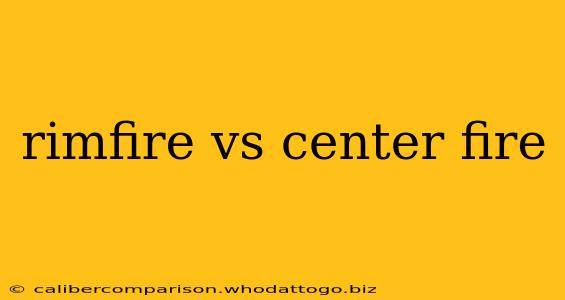Choosing the right ammunition can significantly impact your shooting experience, whether you're a seasoned marksman or a novice. One of the most fundamental distinctions in ammunition types lies in the location of the primer: rimfire versus centerfire. This comprehensive guide will delve into the key differences, advantages, and disadvantages of each, helping you make informed decisions based on your specific needs and preferences.
Understanding the Fundamentals: Primer Location
The core difference between rimfire and centerfire ammunition lies in where the primer—the small explosive charge that ignites the propellant—is located.
-
Rimfire: The primer is contained within the rim of the cartridge case. When the firing pin strikes the rim, it crushes the primer, initiating the firing sequence.
-
Centerfire: The primer is located in a separate cup embedded in the center of the cartridge case's base. The firing pin strikes this central primer, setting off the propellant.
Rimfire Ammunition: Pros and Cons
Rimfire ammunition, known for its affordability and ease of use, is popular among beginners and plinkers. However, it also has certain limitations.
Advantages of Rimfire:
- Cost-effectiveness: Rimfire ammunition is generally much cheaper than centerfire, making it ideal for high-volume shooting practice.
- Simplicity: The design is simpler, leading to lower manufacturing costs.
- Lightweight: Rimfire rounds are often lighter than their centerfire counterparts, making them suitable for small-caliber firearms.
Disadvantages of Rimfire:
- Lower Power: Rimfire cartridges typically generate lower velocities and less stopping power compared to centerfire rounds.
- Primer Sensitivity: Rimfire primers are more sensitive to environmental factors like temperature and humidity, potentially leading to misfires or erratic performance.
- Limited Caliber Selection: The range of available calibers is narrower than that offered by centerfire ammunition.
- Higher Chance of Misfires: The integrated nature of the primer can lead to increased misfires due to damaged rims or insufficient impact force.
Centerfire Ammunition: Pros and Cons
Centerfire ammunition dominates the hunting, self-defense, and high-power shooting markets. Its superior performance comes with a higher price tag.
Advantages of Centerfire:
- Higher Power: Centerfire cartridges offer significantly greater power and stopping power than rimfire rounds.
- Greater Accuracy: The more robust cartridge design often results in better accuracy and precision.
- Wider Caliber Selection: A far broader range of calibers and bullet types is available, allowing for customization based on specific shooting requirements.
- Re-loadability: Many centerfire cartridges can be reloaded, offering cost savings in the long run for experienced shooters.
Disadvantages of Centerfire:
- Higher Cost: Centerfire ammunition is considerably more expensive than rimfire ammunition.
- More Complex: The more intricate design leads to higher manufacturing costs and potentially more complex firearm mechanisms.
- More Recoil: The increased power of centerfire cartridges results in greater recoil, which can be challenging for less experienced shooters.
Choosing the Right Ammunition: Factors to Consider
The best ammunition choice depends heavily on your specific needs and intended use.
- Intended Use: Target shooting, hunting, self-defense, or plinking all have different requirements.
- Budget: Rimfire is a budget-friendly option for practice and plinking, while centerfire is preferred for hunting and self-defense.
- Firearm Type: Your firearm's caliber and design will dictate the type of ammunition it can use.
- Experience Level: Beginners might find rimfire easier to handle due to its lower recoil, while experienced shooters may prefer the power and accuracy of centerfire.
Conclusion
Understanding the fundamental differences between rimfire and centerfire ammunition empowers you to make informed choices based on your individual needs and shooting preferences. By carefully considering the pros and cons of each type, you can select the right ammunition to optimize your shooting experience, ensuring both safety and effectiveness. Always consult your firearm's owner's manual for specific ammunition recommendations.

